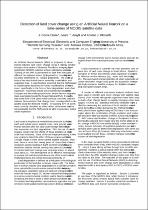 ResearchSpace
ResearchSpace
Detection of land cover change using an Artificial Neural Network on a time-series of MODIS satellite data
JavaScript is disabled for your browser. Some features of this site may not work without it.
- ResearchSpace
- →
- Research Publications/Outputs
- →
- Conference Publications
- →
- View Item
| dc.contributor.author |
Olivier, JC

|
|
| dc.contributor.author |
Araya, ST

|
|
| dc.contributor.author |
Wessels, Konrad J

|
|
| dc.date.accessioned | 2008-01-25T14:24:37Z | |
| dc.date.available | 2008-01-25T14:24:37Z | |
| dc.date.issued | 2007-11 | |
| dc.identifier.citation | Olivier, JC, Araya ST and Wessels KJ. 2007. Detection of land cover change using an Artificial Neural Network on a time-series of MODIS satellite data.PRASA 2007: 18th Annual Symposium of the Pattern Recognition Association of South Africa (PRASA), Pietermaritzburg, Kwazulu-Natal, South Africa, 28-30 November 2007, pp 4 | en |
| dc.identifier.isbn | 978-1-86840-656-2 | |
| dc.identifier.uri | http://hdl.handle.net/10204/1988 | |
| dc.description | 2007: PRASA | en |
| dc.description.abstract | An Artificial Neural Network (ANN) is proposed to detect human-induced land cover change using a sliding window through a time-series of Moderate Resolution Imaging Spectroradiometer (MODIS) satellite surface reflectance pixel values. Training of the ANN is performed on data from two pairs of different, but adjacent areas: (i) degraded vs. non-degraded and (ii) urban settlements vs. natural grasslands. The close proximity of the sites limited natural variability in rainfall, soils and vegetation type. It was therefore assumed that the ANN based its classification decisions on human modifications of the land cover, specifically in the form of land degradation and urban expansion. Numerical results are presented for locations in the Limpopo and Mpumalanga provinces, where the non-degraded class was located inside the Kruger National Park. It was found that some 80% of the pixels were correctly classified, and simulations demonstrated that change from non-degraded to degraded could be detected reliably. In Gauteng 87% of pixels were correctly classified as either urban settlements and natural grasslands and the ANN would be able to accurately detect urban expansion | en |
| dc.language.iso | en | en |
| dc.publisher | 18th Annual Symposium of the Pattern Recognition Association of South Africa (PRASA) | en |
| dc.subject | Artificial neural network | en |
| dc.subject | Land cover change | en |
| dc.subject | MODIS | en |
| dc.title | Detection of land cover change using an Artificial Neural Network on a time-series of MODIS satellite data | en |
| dc.type | Conference Presentation | en |
| dc.identifier.apacitation | Olivier, J., Araya, S., & Wessels, K. J. (2007). Detection of land cover change using an Artificial Neural Network on a time-series of MODIS satellite data. 18th Annual Symposium of the Pattern Recognition Association of South Africa (PRASA). http://hdl.handle.net/10204/1988 | en_ZA |
| dc.identifier.chicagocitation | Olivier, JC, ST Araya, and Konrad J Wessels. "Detection of land cover change using an Artificial Neural Network on a time-series of MODIS satellite data." (2007): http://hdl.handle.net/10204/1988 | en_ZA |
| dc.identifier.vancouvercitation | Olivier J, Araya S, Wessels KJ, Detection of land cover change using an Artificial Neural Network on a time-series of MODIS satellite data; 18th Annual Symposium of the Pattern Recognition Association of South Africa (PRASA); 2007. http://hdl.handle.net/10204/1988 . | en_ZA |
| dc.identifier.ris | TY - Conference Presentation AU - Olivier, JC AU - Araya, ST AU - Wessels, Konrad J AB - An Artificial Neural Network (ANN) is proposed to detect human-induced land cover change using a sliding window through a time-series of Moderate Resolution Imaging Spectroradiometer (MODIS) satellite surface reflectance pixel values. Training of the ANN is performed on data from two pairs of different, but adjacent areas: (i) degraded vs. non-degraded and (ii) urban settlements vs. natural grasslands. The close proximity of the sites limited natural variability in rainfall, soils and vegetation type. It was therefore assumed that the ANN based its classification decisions on human modifications of the land cover, specifically in the form of land degradation and urban expansion. Numerical results are presented for locations in the Limpopo and Mpumalanga provinces, where the non-degraded class was located inside the Kruger National Park. It was found that some 80% of the pixels were correctly classified, and simulations demonstrated that change from non-degraded to degraded could be detected reliably. In Gauteng 87% of pixels were correctly classified as either urban settlements and natural grasslands and the ANN would be able to accurately detect urban expansion DA - 2007-11 DB - ResearchSpace DP - CSIR KW - Artificial neural network KW - Land cover change KW - MODIS LK - https://researchspace.csir.co.za PY - 2007 SM - 978-1-86840-656-2 T1 - Detection of land cover change using an Artificial Neural Network on a time-series of MODIS satellite data TI - Detection of land cover change using an Artificial Neural Network on a time-series of MODIS satellite data UR - http://hdl.handle.net/10204/1988 ER - | en_ZA |





